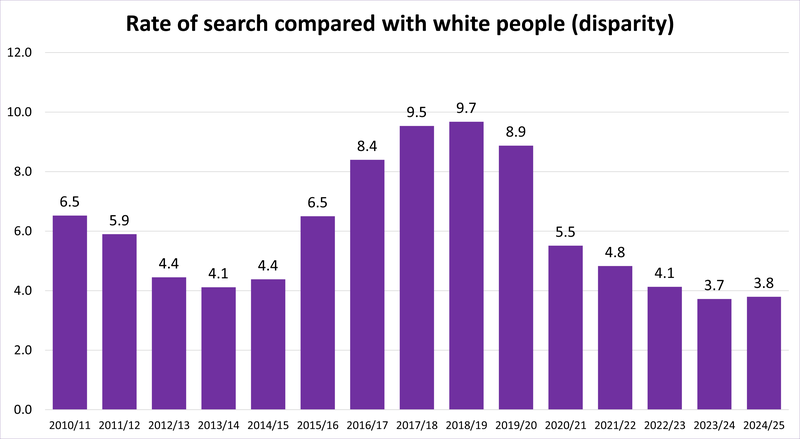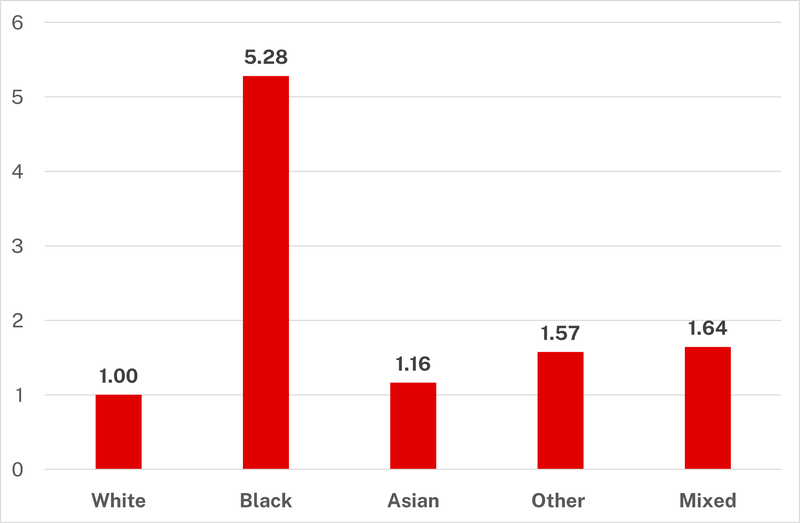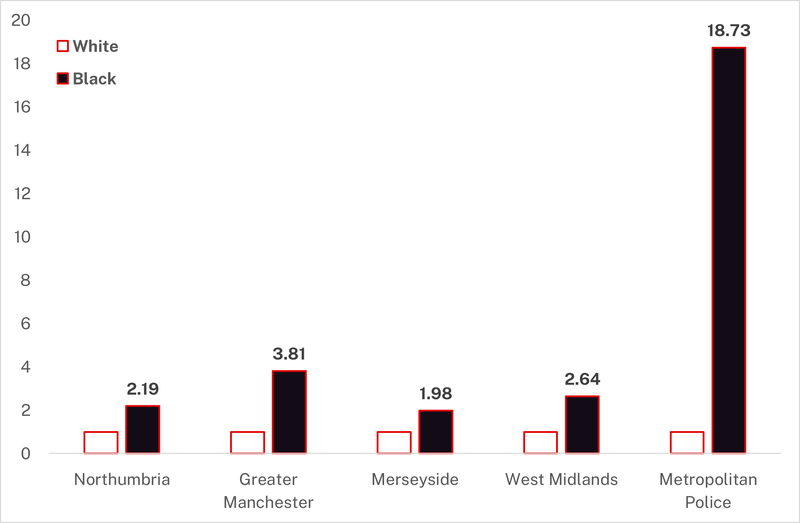Figures published in the latest 'Stop and search, arrests, and mental health detentions, March 2025' statistical bulletin (published 6 November 2025) demonstrate an increasing tendency of some of the country's largest police forces in and England and Wales to use search powers without suspicion.
There were a total of 528,582 stop-searches in 2024/25, -1.4% on the previous period (536,217 searches in 2023/24). The fall was driven by a decrease in searches under section 1 and associated legislation (from 530,863 in 2023/24 to 522,670 in 2024/25), which by sheer volume masked increases in the use of suspicionless stop-search powers.
Rise of the suspicionless search
The year-on-year increases in stop-searches to 31 March 2025 derived from three powers: 1) section 60 of the Criminal Justice Act 1994; 2) section 342E of the Sentencing Code (as inserted by the Police Crime Sentencing and Courts Act 2022); and 3) section 11 of the Public Order Act 2023. The common factor between these powers is that none of them require officers to have or provide grounds for having 'reasonable suspicion' of the individual they wish to search.
Political rhetoric encouraging the use of such powers is reflected in the actions of certain forces. As the force that conducted the most stop-searches after the Metropolitan police, Merseyside police drove the biggest year-on-year increases: they conducted 1,810 section 60 searches in 2024/25, +177.6% on 2023/24 (652); and 194 section 342E searches for Serious Violence Reduction Orders, +288% on 2023/24 (50).
Returns were typically low. Merseyside police made only 36 arrests from section 60 searches in 2024/25. a sharp rise in annual section 60 searches in Cumbria (from 2 in 2023/24 to 92 in 2024/25) resulted in only 2 arrests; and Lincolnshire police made no arrests over the same period, despite tripling the number of searches (from 7 to 22).
Merseyside is also one of the pilot areas for Serious Violence Reduction Orders. Already the most frequent users of the power, they upped the number of (section 342E) searches under the Order from 50 to 194. They made 14 arrests from its use. The other three pilot forces made a single arrest between them, the West Midlands generating the arrest from 38 searches of persons with a Serious Violence Reduction Order to their name.
As expected, there was an increase in searches under section 11 of the Public Order Act 2023, from 3 in 2023/24 to 46 searches in 2024/25. This power has so far been taken up solely by the Met police towards protesters. The force made a total of 4 arrests under the power.
On stop-search outcomes
15% of stop-searches ended in arrest, a very small rise on last year (14.3%) reflecting a long-running inverse relationship between stop-search volumes and arrests from the use of the tactic.
Searches ending in No Further Action fell two percentage points from 69% to 67%. The recategorisation of recorded non-arrest alternatives allows us to identify a potential shift towards a more interventionist type of stop-search policing where officers seek to instruct individuals towards community resolutions and 'voluntary' attendance of correction courses, or give verbal warnings and seize items.
On ethnicity
Disparity ratios
By self-defined ethnicity*, the disparity between Black and white people in stop-searches is roughly the same as the previous year: in 2023/24, Black people in England and Wales were stopped roughly 3.7 times more often. In 2024/25 they were stopped 3.8 times more often.

The differential between was widest amongst the following forces:
- The City of London - 10.9 (Black) : 1 (white)
- Dorset - 8.3 (Black) : 1 (white)
- West Mercia - 7.9 (Black) : 1 (white)
When looking at section 60 searches, Black people were searched 5.3 times more than white people in the year to 31 March 2025.

Racial disparity ratios in England and Wales, section 60 searches
Amongst the forces with the highest volume of searches, the differential is widest between Black and white people searched by Met officers (1: 18.7). This is a stark rise that stands in contrast to previous years of declines in disparity ratios nationally (it was 1: 7.2 in 2022/23 and 6.0 in 2023/24). The change is most likely the result of an operational decision by Met chiefs to use section 60 to target Black people specifically.

Racial disparity ratios for section 60 searches, by Police Force Areas with highest volumes of searches under the power
With 38 arrests from 504 s60 searches, Black people were arrested proportionately 13 times more often then white people (11 arrests from 107 searches) under the power in the capital. But it is important to remember that the numbers are low enough to be subject to vast fluctuations in proportionality. Ultimately, Met officers find nothing in the vast majority of s60 searches: 80 out of 107 searches of white people yielded nothing in 2024/25 (75%), compared with 396 out of 504 searches of Black people (79%).
The 'Not Stated' recording phenomenon
The accuracy of stop-search records is also muddied by the increasing lack of recorded data on the self-defined ethnicities of people searched.
In the last few years, ethnicity was not self-reported in roughly one out of every five stop-searches in England and Wales. This continued in the year to 31 March 2025, with 18% of s1 searches (92,829) and 21% of s60 searches (1,157).
This phenomenon is driven by the actions of London forces. For both the City of London and the Met, 'Not Stated' was more commonly recorded in searches than any single ethnicity. In particular, ethnicity was 'Not Stated' is 36,824 (30%) of 121,148 s1 searches, and 686 (48%) of 1,437 s60 searches by the Met.
It could be argued that the responsibility for accurate police records is a matter of grave concern and that it is forces' statutory duty (according to the Police Act 1996) to ensure best practice in the recording of officer activity in order to better draw conclusions over the efficacy and true purpose of policing operations.
On search by type
As ever, the majority of stop-searches conducted were for drugs: 318,498, or 61% of all searches in 2024/25. There was a small increase in the total number of drugs searches (+1 percentage point) on 2023/24. This contrasts with the number of offensive weapons searches (77,403) which fell 8% on the previous year. Offensive weapons made for 14% of all searches in 2024/25, compared with 16% the previous year.
This tells us that drugs searches remain the operational priority for forces, while some have also intensified their focus on stolen property searches, which increased on the previous year from 60,534 to 64,810. They make up 12.4% of all stop-searches in 2024/25.
In 2024/25 the most significant year-on-year increases in stop-search arrests were for stolen property (+1,838) and drugs (+2,244) masking declines in search arrests for offensive weapons (-671) and going equipped (-480).
For a summary of the data, please find our thread on Twitter.
*NEWS* 'Stop and search, arrests, and mental health detentions, March 2025' shows a small decrease in stop-search volumes by the higher suspicion-led standard (section 1), in contrast to creeping rises in suspicionless searches 🧵 https://t.co/5ISq3qZWpv
— StopWatch UK (@StopWatchUK) November 6, 2025
* self-defined ethnicity is the longest-running measure used to set ethnicity ratios. Other options included by the Office for National Statistics are officer-defined and a combination of self- and officer-defined ethnicity, introduced to plug increasing gaps in ethnicity data reported for searches.